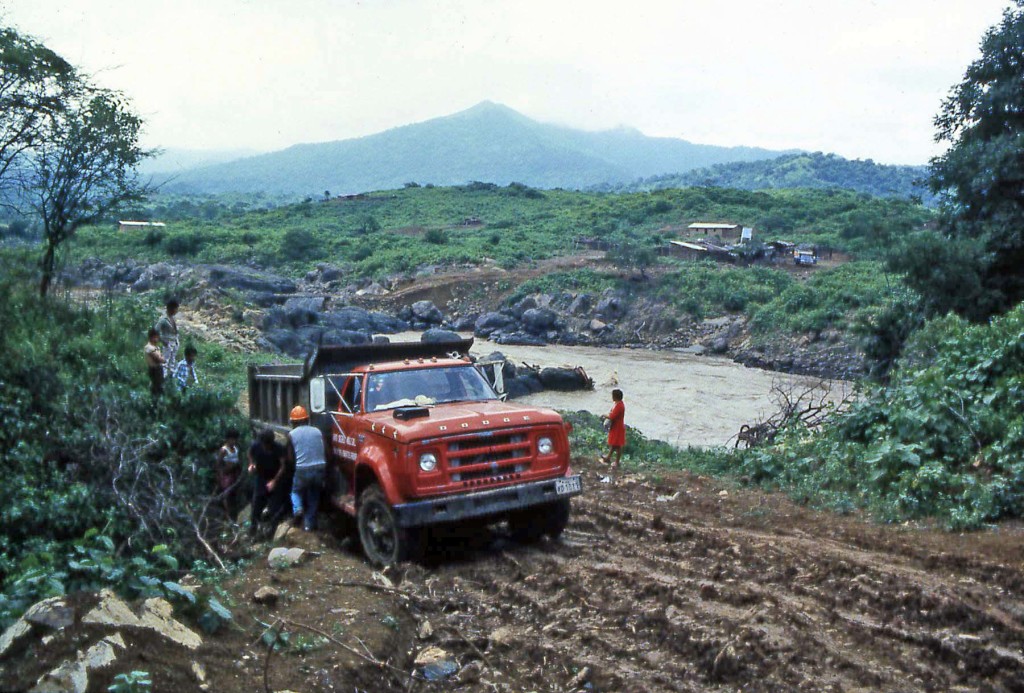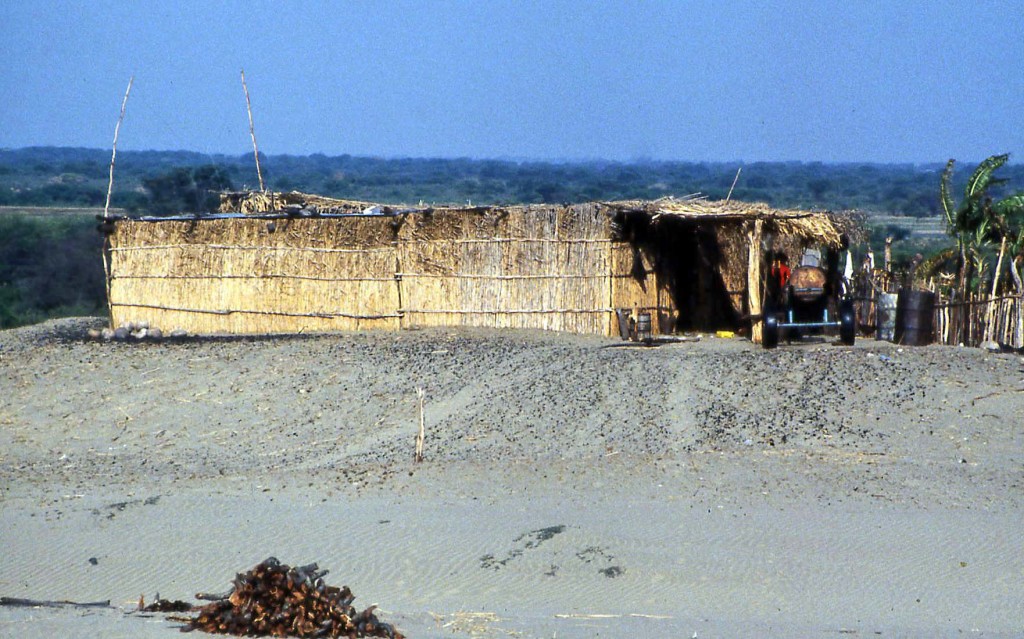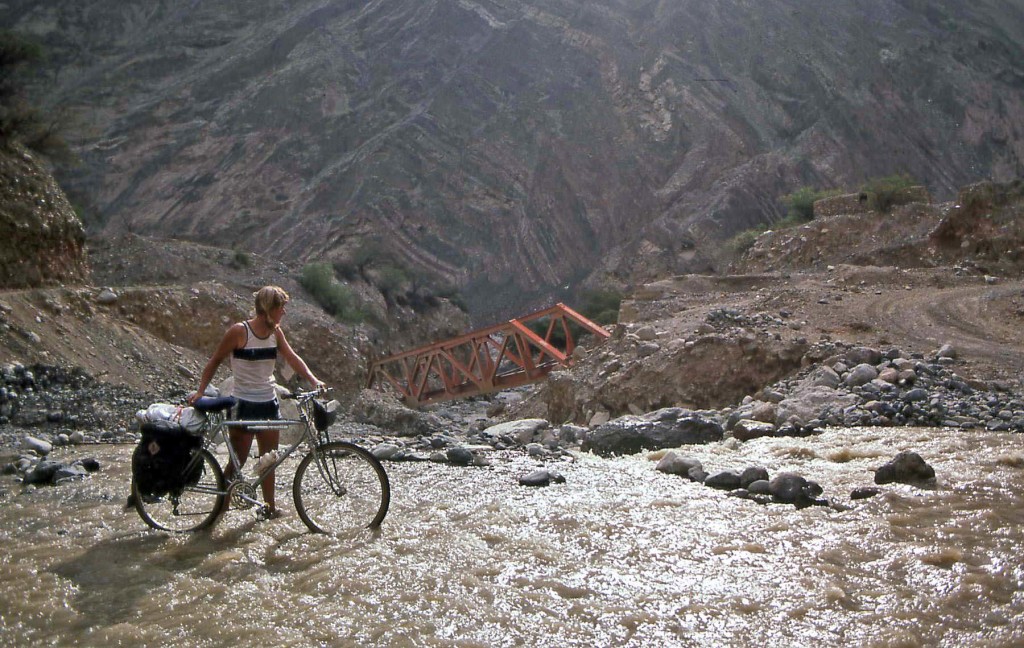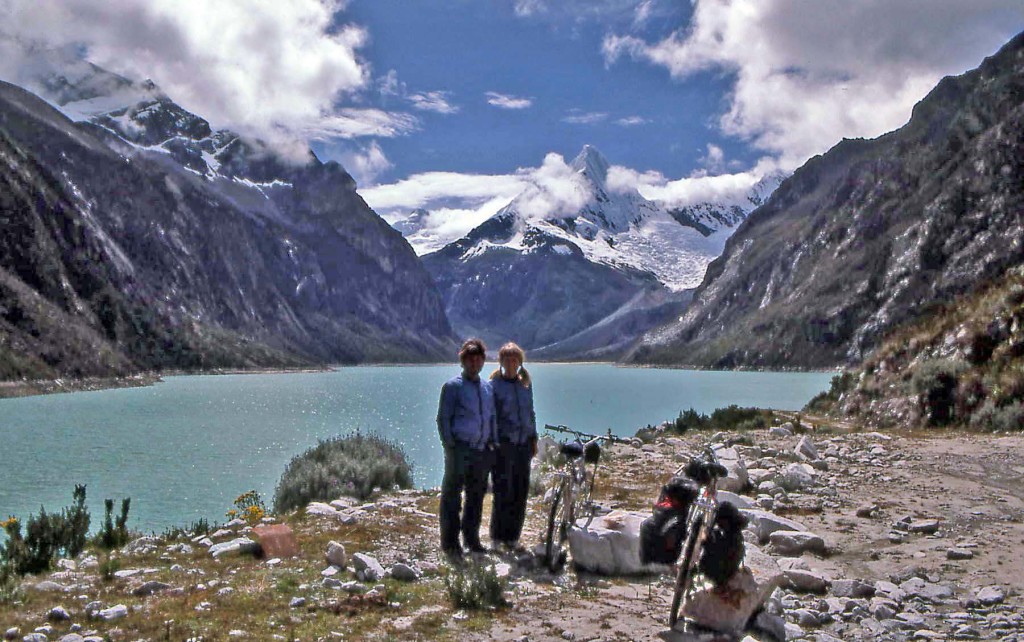We bicycled from Macara and the Ecuadorian border and made it as far as Lima, the capital of Peru, before collapsing in total exhaustion from this 1983-84 bicycling adventure.
The roads were supposed to be paved on the Peruvian side of the border but they were very crude dirt roads; there were several rivers to cross with no bridges.
It was about 10 miles to Suyo, a small town in the middle of nowhere.
With our passports in hand, one of the police asked if we were from Russia.
Being very dirty, we asked for a hotel.
There was a tiny Pension with sheets hanging on a wire to separate the sleeping area from the kitchen.
They took us to their station building and said we could camp on the grass behind.
They warned us, however, not to camp at police stations further into Peru as they were often attacked by guerrillas.
We ate dinner across the street in a typical one room dirt floor kitchen. Prices were higher than Ecuador and the food was poor quality and tiny servings. We were constantly hungry from the multiple days of extreme exertion. Many people from the village ate there however and the lady was very nice.
Talked long into the evening with the police about fighting in Peru. In 1984, one had to be very careful where they traveled in Peru because of the violent attacks on villages by the Shining Path.
Bicycling Peru
Ecuador Border Region
Macara to Sullana-55 miles of mud
It had rained all night but we decided to try bicycling anyway. We were desperate to get to the desert and out of the wet. Went 1/2 mile then encountered a kind, of mud that clung tenaciously to the wheels, clogging the brakes and making travel impossible. We went on for a mile pushing the bikes scraping the mud off with a stick on every revolution to keep the wheels turning.
As soon as the clean part hit the mud, it was totally clogged again.
We sat in the rain for an hour before a dump truck came by.
The mud was so slippery the truck couldn’t negotiate several hills. We scooped mud out of the road with our hands trying to make a track. Cut branches and rocks helped some. We spent 1 hour on a 100 foot hill. On one hill, the truck coming towards us slid sideways and blocked the road; it took 20 people to push him out.
Then it took us 2 hours to negotiate the same hill.
Our driver was very interested in Russian and American aid programs.
He felt America should just give Peru money with no strings attached.
We came to a washed out bridge that had been temporarily replaced by fill dirt and two boards. As the driver approached the extremely narrow crossing, I could see it wasn’t wide enough for the truck. I hollered for him to let us out. Everyone got out of the truck; I wish we had pulled our bikes out too. His wheels lapped over the sides of the dirt fill lowering his truck body about 2 feet. One side started slipping and the truck began to lean. He gunned the engine and by sheer flying made it across.
No wonder these people have statues of Jesus in their windshields.
Bicycling Peru
The Northern Desert
Sullana to Piura-18 miles
Northern Peru which is desert, had been deluged with rain the year before and much of the road system had been flooded out. Huge sections of road would suddenly not be there. Bridges were gone; only about 50% of the new highway remained intact. Sand blew against us, pushed by the strong south head winds that dominated this coast. Though we were not in the rain and cold anymore, the biking was difficult and unpleasant. So much for escaping harsh conditions. What lay ahead would be much worse.
We have been in beautiful deserts where the emptiness is thrilling all by itself.
This desert, however, was rolling sand dunes laced with blowing garbage.
We found the restaurants to be equally unsanitary. There are no menus. They would quote a price, bring the food, then bring a higher bill. When we question this, they’d say we misunderstood.
Men pee in the streets everywhere and don’t turn their backs. It stinks of urine at every wall, corner and rubbish pile. Bathrooms are gross.
The roads in this section were also destroyed by floods; the dust was blinding. Finally, we came to a primitive restaurant where we could take shelter.
Scattered shacks along the way had provided warm sodas, but nothing of substance.
Ate at the restaurant; a bowl of questionable soup; Mike threw the chicken feet out the window behind him. Exhausted after 11 hours and about 65 miles, we found refuge from the wind and set up our tent behind a large sand dune out of sight of the road.
Continue to Chiclayo-65 miles-13 hours
Left before dawn again to beat the wind. We had no lights and neither did the trucks driving on the highway. We could hear them, but not see them. It was frightening.
Today was the hardest day ever psychologically and physically.

Thought we only had 50 miles to go but the maps were wrong. Turned out to be 65 miles. We ran low on water and food.
Ate a can of sardines for the day’s effort.
The city square in Chiclayo was the most beautiful we had seen. The buildings were all new, whitewashed and very European.
But the hotels at our budget level were so gross.
Day Ride to Santa Rosa-20 miles
Rode south along the coast to the little fishing villages. Santa Rosa had over 100 fishing boats 50 feet long lined up on the beach. They push these boats ashore on logs every night and in the morning everyone lends a hand and they push them out into the surf.
As each wave comes to shore and lifts the boat off the sand a little, they heave to.
Pascamayo to Trujillo-60 miles- 12 hours
Nothing much has changed except our resolve. It was another harsh day of cycling through poverty and empty desert.
We were grateful to make it. Trujillo is a lovely colonial city with a large market place and a clean huge antique hotel called the Grand. The rooms were giant and clean. An oasis surrounded by dry sand blown hills and reed shacks.
Trujillo to Chimbote-68 miles-13 hours
We did make it to Chimbote. With a giant sigh of relief, we knew we were going to leave the windy Pan American Highway and head inland into the Andes mountains from there. Anything had to be easier than what we had just endured. We were planning to cycle from the coast to Hylas del Callejon, near Huaraz.
This is the very famous climbing and hiking area that gringos go to. It has some of the most superb trekking in South America.
Bicycling Peru
Up the Santa River into the Andes
Chimbote to 1st river camp-25 miles-8 hours
The road leading off the highway was poor gravel and deep sand; large rocks and washboard surface made it even more difficult. We progressed very slowly.
It was a constant, but gradual uphill grade.
Found a nice place to camp along the river out of sight of the road. We always worried about thieves no matter where we were.
1st river camp to 2nd river camp-30 miles – 7 hours
We kept expecting to reach a small town to buy more food; we ate up the last of our supplies from Santa.
The scenery is becoming lovelier along the river as the mountains rise above us.
2nd river camp to Huallanca-28 miles -7 hours
No breakfast and it took 4 hours to reach Yuri Marca where there was a restaurant. Just about didn’t make it as the roads started climbing seriously. It was impossible to get traction on the rolling rocks and I got a flat tire riding over a thorn bush.
I thought all this exercise would have made me stronger by now but the riding is really gut wrenching.
We continue to find the people very friendly, often pulling up a chair to chat. Still, we face the same problem of gathering information.
Nobody knows how far it is to the next town, but everyone offers an answer.
Santa River Route
This entire route we have been following has the most terrible gravel roads and the most magnificent scenery along the Santa River.
Reaching Huallanca, we were surprised to see two 10-speed bikes in the lobby of the only pension. An English couple had flown to Lima and were just getting started on a hoped for bike tour to Los Angeles, yes in the USA. Upon hitting our fabulous gravel road with their inch and three/eighths tires, they have decided to take the bus down to the coast.
At least they will be cycling in the correct direction. We told them so!
Huallanca to Caraz- 27 miles-8 hours
Flat tires have been a recent problem. Seem to be picking up thorns, 3,4,5 at once. Keep patching the tubes, installing them, only to find out it deflates. Road started to climb straight up as soon as we left town. Entering the incredible Canon del Pato still following the same river high into the Andes.
Why they built a road here is hard to figure.
This is our fourth day on gravel, fourth day climbing. Very slow going. We carried our hiking boots in a gunnysack on the back of my bike. I failed to tie the bag on tight and after climbing 1.5 hrs noticed they were gone. Mike valiantly went all the way back down to Huallanca in hopes of finding them but no luck.
We were delighted to reach Caraz where a paved road climbed from there to 13,000 feet to the outlet lake of the river we are following.
Caraz is a pleasant little town nestled at the lower end of this great valley.
Caraz to Laguna Cancaraga Side Trip
Decided to take a truck 20 miles up into the mountains to get a close look at some of the glaciers. We took our bikes so we could ride back down. The first hour we spent arguing the price of the trip. There are lots of gringos here. Finally 7 of us found a cheaper truck as the first man would not budge from his high price. We went to Laguna Cancaraga. The glacier was beautiful, very much like scenes we were familiar with in British Columbia, Canada.
The ride down took three hours.
Caraz to Yungay to Carhuaz- 25 miles-5 hours
A beautiful day full of sun and pavement. We have definitely had enough gravel road for long distances. We are biking up the valley viewing the great glaciers, green hillsides and quaint villages.
The next 110 miles contains the most popular hiking places in Peru other than Cusco.
Two weeks in Carhuaz area for hiking
For pictures and stories, go to our page Hiking Peru.
After hiking we rested 2 days in Huaraz. Enjoying the good food, pleasant surroundings and no cycling. As it turned out,
Huaraz would be the end of our 5 month long bicycle adventure from Costa Rica to Peru.
Southern Peru By Bus
Lima, Peru
Lima, Peru flourishes amid incredible poverty and incredible wealth. The center of the city is very beautiful, perhaps the most developed and most European we have seen. The city is completely surrounded by desert hills, dry, rocky, barren, and dusty.
Stick houses surround the city.
There is grand wealth too. Beautiful homes with swimming pools, tennis clubs, all the amenities. Cost is slightly higher than Ecuador, but much lower than northern Peru.
A basic hotel in Lima is $4 for 2, with bath down the hall.
One evening we went to a fancy restaurant with live folk music, flute and harp. Dinner prices ranged from $2 to $4. (12 soles = $1). Then the waiter brought another menu with complete dinner for 2 for 12 soles each. Seemed like a good price for salad, dinner, desert and wine. Enjoyed a magnificent meal with wonderful music and began to feel restored again.
Then the bill came, it said $24.00 US.
We blew our lids. They had put the price of the dinner in dollars. I looked at the menu again. There was a small d after the 12 instead of the S with one line through it. My fault.
I told the waiter we were in Peru and the currency in Peru is soles, not dollars. The waiter was turning red from embarrassment.
We attracted much attention from other customers.
Meet many travelers in Lima. One Aussie was walking back from the movies that night in Lima and was robbed by the police. We have heard this before.
He said the police checked him out for a money belt, passport and checked his shoes as well (where we had taken to hiding our money).
Another fellow told us his story when he was in Lima sitting on a park bench. He had one hand on his day pack in his lap; the other hand on the park bench back.
A man stuck a needle into his hand on the park bench and held it in hard. The gringo reached automatically to pull the needle out. Another man from the other side stole his pack from his lap.
Lima is filled with junk cars. Taxis are antique VW Bugs. Taxes are so high no one but the very rich can afford a new car. A Honda 125cc costs $1,800. Sixty percent of that is taxes. Airline tickets have a 21% tax. It seems the government is pricing itself out of business. Nobody is buying.
Tried to change money.
The changer would not take our US $100 bill.
We were having a very difficult time making decisions. We did not want to go home but we desperately needed a break from the strain of so much cycling, and mostly from the constant strain of the thieving, lack of good food, cleanliness and sanitation.
Five months of constant poor living conditions were wearing us down.
We were losing sight of our purpose.
To cycle on to Bolivia and Chile would have taken at least another 4 months. From Lima to Bolivia we would have to cross 5 major passes on dirt roads. We could not go direct because of the terrorist trouble. A detour of a 1000 miles through Arequipa to the south, then Puno, then back north to Cusco. We read the description of the roads from Puno to Bolivia to Northern Argentina. They were deserted, rugged high altitude roads which would have been a trek in themselves.
By the time we figured we’d make it to Chile, it would be the middle their winter.
We decided to take the bus to Arequipa then Cusco before going home. It was a 20 hour ride. Bus falling apart. Window stuck shut, seat didn’t work, rattles everywhere. It was a tiring journey and the scenery was desert all the way.
One thing for sure. It would have been awful to bike it.
Arequipa
We arrived in Arequipa after dark. A lady off the bus offered to guide us to a cheap hotel. We carried our bike bags in our arms; walking down the street we felt very vulnerable. The streets were overflowing with people bumping and jostling us as they went by.
A local man was getting out of a taxi and in reaching for his pocket money, was hit from behind by 2 youths.
Found superb quality Alpaca hats at a cooperative.
Arequipa is an artistic town with many craftspeople.
Train to Juliaca was to leave station at 9am. Got there at 8:30 but it had already left. No train for 2 more days. Scurried back to city center and found Air Peru flight leaving in one hour. Rushed to airport. Flight took 15 minutes as opposed to 10 hours by train.
Lake Titicaca
Lake Titicaca is huge, country side barren but beautiful. Live flute music incredible. Boat to island of Taquile… moved along about 5 mph. Leaves when it wants, depends on when it fills up. Indians speak Quechuan, some Spanish. It’s difficult to tell if they understand or not as we sometimes get directions where they point to the right but say the Spanish word for left.
Juliaca
Taxis at Juliaca quoted $1 for ride to town. Took taxis. Paid $5 bill. Man gave back $2 change. Typical method of deception. Charge is per person, not for the taxis. Also he took us three blocks past the normal taxis stop ( which of course he forgot to mention. That cost another $1.
Once you give them the money, you can’t get it back.
Spent the day in Juliaca buying hats. Streets are filled with vendors sitting in the gutters selling their goods. There must be three hundred people lining the streets selling the same variety of things. Juliaca is a market town. Everyone sells wool goods to the tourists.
All the Indians are very poor but at least they do have their wool to sell.
Cusco
Train to Cusco. Machu Pichu. Yes, we went to the famous ruins. What a treasure they are. Utterly fascinating. I’m glad we took the opportunity to come this far, even though we did not bicycle it. Our adventure was over. We were going home via two weeks cycling around Jamaica. That’s another tale!
Copyright Material
All rights reserved. No part of this page may be reproduced or utilized in any form by any means, electronic or mechanical, including downloading, print screen, photocopying, recording, or by any information storage or retrieval system, without the prior written permission by the copyright owner.


































